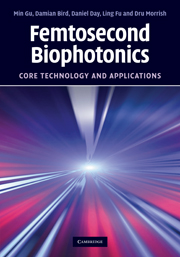Book contents
- Frontmatter
- Contents
- Preface
- 1 Introduction
- 2 Nonlinear optical microscopy
- 3 Two-photon fluorescence microscopy through turbid media
- 4 Fibre-optical nonlinear microscopy
- 5 Nonlinear optical endoscopy
- 6 Trapped-particle near-field scanning optical microscopy
- 7 Femtosecond pulse laser trapping and tweezers
- 8 Near-field optical trapping and tweezers
- 9 Femtosecond cell engineering
- Index
3 - Two-photon fluorescence microscopy through turbid media
Published online by Cambridge University Press: 07 May 2010
- Frontmatter
- Contents
- Preface
- 1 Introduction
- 2 Nonlinear optical microscopy
- 3 Two-photon fluorescence microscopy through turbid media
- 4 Fibre-optical nonlinear microscopy
- 5 Nonlinear optical endoscopy
- 6 Trapped-particle near-field scanning optical microscopy
- 7 Femtosecond pulse laser trapping and tweezers
- 8 Near-field optical trapping and tweezers
- 9 Femtosecond cell engineering
- Index
Summary
As discussed in Chapters 1 and 2, biological tissue is a highly scattering medium which will affect image resolution, contrast and signal level. This chapter discusses the effect of multiple scattering in a tissue-like turbid medium on two-photon fluorescence microscopy. Section 3.1 discusses a model based on imaging of microspheres embedded in a turbid medium. A quantitative study of the limiting factors on image quality is given in Section 3.2. In particular, the limitation on the penetration depth in turbid media, revealed from Monte-Carlo simulation and experimental measurements, is presented in Section 3.3.
Two-photon fluorescence microscopy of microspheres embedded in turbid media
Two-photon fluorescence microscopy has been extensively used due to its significant advantages over single-photon fluorescence microscopy. This technology has been used for in vivo imaging of thick biological samples. Since the required image information is taken at a large depth within a biological specimen, optical multiple scattering within tissue may result in a severe distortion on images obtained in this situation. Thus, the effect of optical multiple scattering on fluorescence image quality should be understood if high quality images are to be obtained at significant depths into a biological specimen. In this section, we present measured images of small fluorescent microspheres embedded in a turbidmedium which has different scattering characteristics under singlephoton and two-photon excitation. Imaging of small spheres embedded in a turbid medium has practical importance since it can be considered to be an approximate model of imaging small tumours embedded in biological tissue.
- Type
- Chapter
- Information
- Femtosecond BiophotonicsCore Technology and Applications, pp. 35 - 50Publisher: Cambridge University PressPrint publication year: 2010



